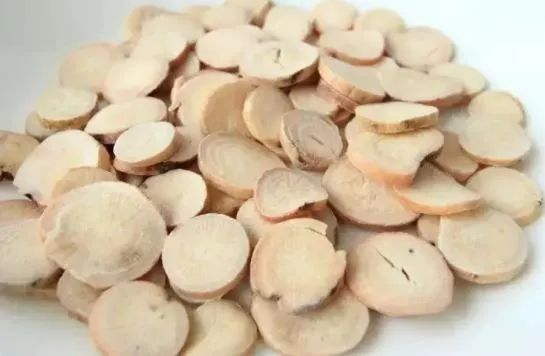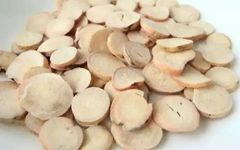Bai Shao (White Peony) is the dried root of the plant Paeonia lactiflora, belonging to the family Ranunculaceae. The Shen Nong Ben Cao Jing (Shen Nong’s Classic of Materia Medica) first records the properties and therapeutic effects of Bai Shao, while the Ben Cao Jing Ji Zhu (Compendium of Materia Medica) classifies it into Bai Shao and Chi Shao (Red Peony). In Traditional Chinese Medicine (TCM), there are 21 documented methods for processing Bai Shao, including cleansing, slicing, and adding auxiliary materials. Modern processed forms of Bai Shao mainly include Jiu Bai Shao (Wine-processed White Peony), Chao Bai Shao (Stir-fried White Peony), and Fu Chao Bai Shao (Wheat bran stir-fried White Peony). Today, we will explore the various traditional processing techniques of Bai Shao.

In the Wushi Er Bing Fang (Fifty-Two Disease Formulas), the term “xie” in “xie shao yao” means to crush, marking the first record of the slicing method for Bai Shao. The Leigong Pao Zhi Lun (Treatise on the Processing of Medicinals) from the Liu Song period describes the methods of “sun drying at noon,” “removing the skin,” “filing,” and “mixing with honey,” which detail the auxiliary materials, processing techniques, and levels of processing for Bai Shao. Before use, Bai Shao is often peeled, and its slicing methods include filing into pieces, fine slicing, and cutting into slices. Over generations, methods such as decocting, wine processing, and stewing have been developed. Bai Shao is mostly used raw; if there is abdominal cold, it is stewed; for avoiding cold and postpartum blood deficiency, it is stir-fried with wine or ginger; for entering the blood, stopping bleeding, and astringing blood, it is stir-fried with vinegar; for nourishing blood, it is stir-fried with honey; and washing with wine for raw use can eliminate blood heat and carbuncles, while processing with cinnamon wine can alleviate abdominal distension, edema, and blood deficiency.
Common modern processing techniques include:
① Chao Bai Shao: Take clean Bai Shao slices, place them in a pan, and stir-fry over low heat until slightly yellow, then remove and let cool; or take clean Bai Shao slices, heat in a pan, and immediately stir with an iron rake until slightly colored, then remove and let cool; or take Bai Shao slices and stir-fry over high heat until the surface is slightly yellow, then remove and let cool.
② Jiu Bai Shao: Take Bai Shao slices, evenly spray with yellow wine, slightly moisten, and stir-fry over low heat until removed and cooled; or mix Bai Shao with wine, let it sit for a while, and stir-fry until the surface color deepens, then remove and spread to cool; or take Bai Shao slices, mix with yellow wine, let sit for 1-2 hours until the wine is absorbed, then stir-fry over low heat until slightly yellow, remove, cool, and sift out debris; or take Bai Shao slices, spray with yellow wine, mix evenly, let sit, and stir-fry over low heat until slightly colored, then remove and let cool; use 10 kg of yellow wine for every 100 kg of Bai Shao.
③ Tu Chao Bai Shao: Take Bai Shao, wash, moisten, cut into thin slices, dry, and stir-fry with fine yellow earth powder over low heat until the surface is coated with earth color, then remove, sift out excess earth, and let cool; or take Bai Shao, place in a hot pan, sprinkle with Fu Long Gan (a type of earth), and stir-fry until it turns earth yellow, then remove and sift out the earth powder, let cool; or take Bai Shao slices and stir-fry with stove heart earth until the outside is earth yellow and the inside is slightly yellow.
④ Fu Chao Bai Shao: Take honey-fried wheat bran, place in a hot pan, stir until it smokes, add Bai Shao, and quickly stir-fry until the surface is deep yellow and the broken surface shows slight yellow, then remove, sift out the bran, and let cool; take wheat bran, sprinkle in a hot pan, heat over medium heat until it smokes, then add clean Bai Shao slices, stir-fry until the surface is yellow, remove, cool, and sift out the bran; first heat the pan over high heat, evenly sprinkle in the bran, and when it smokes, add clean Bai Shao slices, quickly stir-fry until the surface is yellow, then quickly remove, sift out the burnt bran, and let cool; take wheat bran, sprinkle in a hot pan, heat until smoke rises, then add clean Bai Shao, quickly stir-fry over high heat until tender yellow, remove, sift out the bran, and let cool; use 10-15 kg of wheat bran for every 100 kg of Bai Shao.
⑤ Cu Bai Shao: Take Bai Shao slices, mix with rice vinegar, let sit for a while, then place in a pan and heat over low heat until dry, remove and let cool; take raw Bai Shao, mix with vinegar, let sit, and stir-fry over low heat until slightly yellow, then remove and let cool; take clean Bai Shao slices, mix with rice vinegar, let sit for 1-2 hours, then place in a pan and stir-fry over low heat until the surface is slightly yellow, remove and let cool; take clean Bai Shao slices, add a specified amount of rice vinegar, mix evenly, let sit until the vinegar is fully absorbed, then place in the processing container, heat over low heat until dry, remove, spread to cool, and sift out debris; use 10-20 kg of vinegar for every 100 kg of Bai Shao.
⑥ Jiao Bai Shao: Take Bai Shao slices, place in a pan, first stir-fry over high heat and then over low heat until the surface is black-brown and the inside is deep brown, remove and let cool; take Bai Shao slices, stir-fry over high heat until焦黄色, remove and let cool; take clean Bai Shao slices, place in a hot pan, stir-fry over medium heat until the surface is焦黄色, and the broken surface deepens in color; take clean Bai Shao, place in a pan, heat over high heat, and stir-fry until the surface is焦褐色, then remove and let cool.
⑦ Bai Shao Tan: Take Bai Shao slices, place in a pan, stir-fry over strong heat until焦黑色 (but must retain its properties), remove, spray with water to extinguish fire sparks, and let dry; take raw Bai Shao, stir-fry according to the charcoal method until the outside is焦黑色 and the inside is老黄色, sift out ash; take clean Bai Shao slices, place in a pan, stir-fry over high heat until the surface is黑褐色 and the inside is黑褐色, spray with a little clean water to extinguish fire sparks, remove, and spread to cool; take clean Bai Shao slices, stir-fry according to the charcoal method until the surface is焦黑色 and the inside is黑褐色; take clean Bai Shao, place in the processing container, heat over high heat, stir-fry until the surface is焦黑色 and the inside is焦褐色, spray with a little clean water to extinguish fire sparks, remove, and spread to cool.
In addition, the Zhang Bang processing school has a famous processing technique for Bai Shao slices, where experienced processors can cut a 1-inch long Bai Shao into over 300 slices, describing Bai Shao slices as thin as cicada wings. The production method is: take raw materials → remove impurities → soak in 60°C water for 1 hour → let sit for 72 hours → cut into slices with a thickness of 0.5 mm. The processed Bai Shao slices have functions such as nourishing blood, regulating menstruation, astringing yin, stopping sweating, softening the liver, alleviating pain, and calming liver yang.
Copywriter: Zhang Yifei
Editor: Li Yuan
References:
[1] Ye Xianwen, Xia Lanting, Ren Hongmin, Deng Yaling, Yang Ming, Zhang Jinlian, Chen Xu, Liu Haiping, Zhang Qi. Research Progress on the Historical Evolution, Chemical Composition, and Pharmacological Effects of Bai Shao Processing [J]. Zhong Cao Yao, 2020, 51(07): 1951-1969.
[2] Ma Lingzhen, Ma Yali, Liu Yaowu. Optimal Selection of Different Processing Techniques for Bai Shao [J]. Liaoning University of Traditional Chinese Medicine Journal, 2019, 21(02): 69-73.


